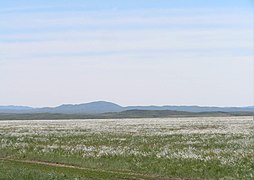
The Silk Road was a network of Eurasian trade routes active from the second century BCE until the mid-15th century. Spanning over 6,400 kilometers, it played a central role in facilitating economic, cultural, political, and religious interactions between the East and West. The name "Silk Road", first coined in the late 19th century, has fallen into disuse among some modern historians in favor of Silk Routes, on the grounds that it more accurately describes the intricate web of land and sea routes connecting Central, East, South, Southeast, and West Asia, East Africa, and Southern Europe.

The Saka, Shaka, or Sacae were a group of nomadic Eastern Iranian peoples who historically inhabited the northern and eastern Eurasian Steppe and the Tarim Basin.
The Pazyryk culture is a Saka nomadic Iron Age archaeological culture identified by excavated artifacts and mummified humans found in the Siberian permafrost, in the Altay Mountains, Kazakhstan and nearby Mongolia. The mummies are buried in long barrows similar to the tomb mounds of Scythian culture in Ukraine. The type site are the Pazyryk burials of the Ukok Plateau. Many artifacts and human remains have been found at this location, including the Siberian Ice Princess, indicating a flourishing culture at this location that benefited from the many trade routes and caravans of merchants passing through the area. The Pazyryk are considered to have had a war-like life. The Pazyryk culture was preceded by the "Arzhan culture".

The history of Eurasia is the collective history of a continental area with several distinct peripheral coastal regions: the Middle East, South Asia, East Asia, Southeast Asia, and Western Europe, linked by the interior mass of the Eurasian steppe of Central Asia and Eastern Europe. Perhaps beginning with the Steppe Route trade, the early Silk Road, the Eurasian view of history seeks establishing genetic, cultural, and linguistic links between Eurasian cultures of antiquity. Much interest in this area lies with the presumed origin of the speakers of the Proto-Indo-European language and chariot warfare in Central Eurasia.
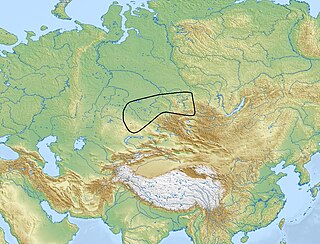
The Karasuk culture describes a group of late Bronze Age societies who ranged from the Aral Sea to the upper Yenisei in the east and south to the Altai Mountains and the Tian Shan in ca. 1500–800 BC.
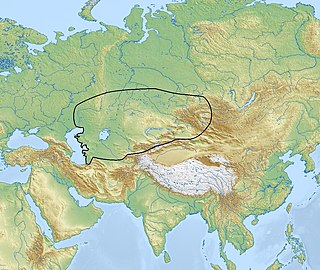
The Andronovo culture is a collection of similar local Late Bronze Age cultures that flourished c. 2000–1150 BC, spanning from the southern Urals to the upper Yenisei River in central Siberia. Some researchers have preferred to term it an archaeological complex or archaeological horizon. The slightly older Sintashta culture, formerly included within the Andronovo culture, is now considered separately to Early Andronovo cultures. New research shows Andronovo culture's first stage could have begun at the end of the 3rd millennium BC, with cattle grazing, as natural fodder was by no means difficult to find in the pastures close to dwellings.

The history of Central Asia concerns the history of the various peoples that have inhabited Central Asia. The lifestyle of such people has been determined primarily by the area's climate and geography. The aridity of the region makes agriculture difficult and distance from the sea cut it off from much trade. Thus, few major cities developed in the region. Nomadic horse peoples of the steppe dominated the area for millennia.
The Afanasievo culture, or Afanasevo culture, is an early archaeological culture of south Siberia, occupying the Minusinsk Basin and the Altai Mountains during the eneolithic era, c. 3300 to 2500 BCE. It is named after a nearby mountain, Gora Afanasieva in what is now Bogradsky District, Khakassia, Russia. Afanasievo burials have been found as far as Shatar Chuluu in central Mongolia, confirming a further expansion about 1,500 km beyond the Altai mountains. The Afanasievo culture is now considered as an integral part of the Prehistory of Western and Central Mongolia.

The Eurasian nomads were groups of nomadic peoples living throughout the Eurasian Steppe, who are largely known from frontier historical sources from Europe and Asia.
Nomadic pastoralism is a form of pastoralism in which livestock are herded in order to seek for fresh pastures on which to graze. True nomads follow an irregular pattern of movement, in contrast with transhumance, where seasonal pastures are fixed. However, this distinction is often not observed and the term 'nomad' used for both—and in historical cases the regularity of movements is often unknown in any case. The herded livestock include cattle, water buffalo, yaks, llamas, sheep, goats, reindeer, horses, donkeys or camels, or mixtures of species. Nomadic pastoralism is commonly practised in regions with little arable land, typically in the developing world, especially in the steppe lands north of the agricultural zone of Eurasia.

The Ordos culture was a material culture occupying a region centered on the Ordos Loop during the Bronze and early Iron Age from the 6th to 2nd centuries BCE. The Ordos culture is known for significant finds of Scythian art and may represent the easternmost extension of Indo-European Eurasian nomads, such as the Saka, or may be linkable to Palaeo-Siberians or Yeniseians. Under the Qin and Han dynasties, the area came under the control of contemporaneous Chinese states.

The Eurasian Steppe, also simply called the Great Steppe or the steppes, is the vast steppe ecoregion of Eurasia in the temperate grasslands, savannas and shrublands biome. It stretches through Hungary, Bulgaria, Romania, Moldova, Ukraine, western Russia, Siberia, Kazakhstan, Xinjiang, Mongolia and Manchuria, with one major exclave, the Pannonian steppe, located mostly in Hungary.

Nomadic empires, sometimes also called steppe empires, Central or Inner Asian empires, were the empires erected by the bow-wielding, horse-riding, nomadic people in the Eurasian Steppe, from classical antiquity (Scythia) to the early modern era (Dzungars). They are the most prominent example of non-sedentary polities.
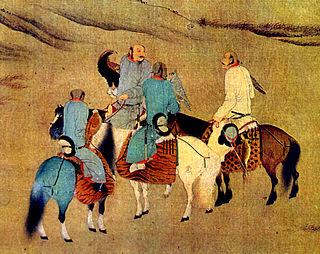
Hunting with eagles is a traditional form of falconry found throughout the Eurasian Steppe, practiced by ancient Khitan and Turkic peoples. Today it is practiced by Kazakhs and the Kyrgyz in contemporary Kazakhstan and Kyrgyzstan, as well as diasporas in Bayan-Ölgii Provinces Bayan-Ölgii, Mongolia, and Xinjiang, China. Though these people are most famous for hunting with golden eagles, they have been known to train northern goshawks, peregrine falcons, saker falcons, and more.
Glazkov culture is an archaeological culture of possibly proto-Tungusic tribes in the Bronze Age, spread in the Baikal area.
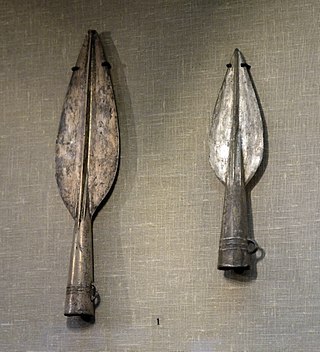
The Seima-Turbino phenomenon is a pattern of burial sites with similar bronze artifacts dated to c. 2300–1700 BCE found across northern Eurasia, particularly Siberia and Central Asia, maybe from Fennoscandia to Mongolia, Northeast China, Russian Far East, Korea, and Japan. The homeland is considered to be the Altai Mountains. These findings have suggested a common point of cultural origin, possession of advanced metal working technology, and unexplained rapid migration. The buried were nomadic warriors and metal-workers, traveling on horseback or two-wheeled carts.

This article summarizes the History of the eastern steppe, the eastern third of the Eurasian Steppe, that is, the grasslands of Mongolia and northern China. It is a companion to History of the central steppe and History of the western steppe. Most of its recorded history deals with conflicts between the Chinese and the steppe nomads. Most of the sources are Chinese.
The Inner Asian Mountain Corridor (IAMC) was an ancient exchange route ranging from the Altai Mountains in Siberia to the Hindu Kush, which took shape in the 3rd millennium BCE. The expansion of the Indo-European Andronovo culture towards the Bactria-Margiana Culture in the second millennium BCE took place along the IAMC, giving way to the Indo-Aryan migration into South Asia.

The Scytho-Siberian world was an archaeological horizon which flourished across the entire Eurasian Steppe during the Iron Age from approximately the 9th century BC to the 2nd century AD. It included the Scythian, Sauromatian and Sarmatian cultures of Eastern Europe, the Saka-Massagetae and Tasmola cultures of Central Asia, and the Aldy-Bel, Pazyryk and Tagar cultures of south Siberia.






